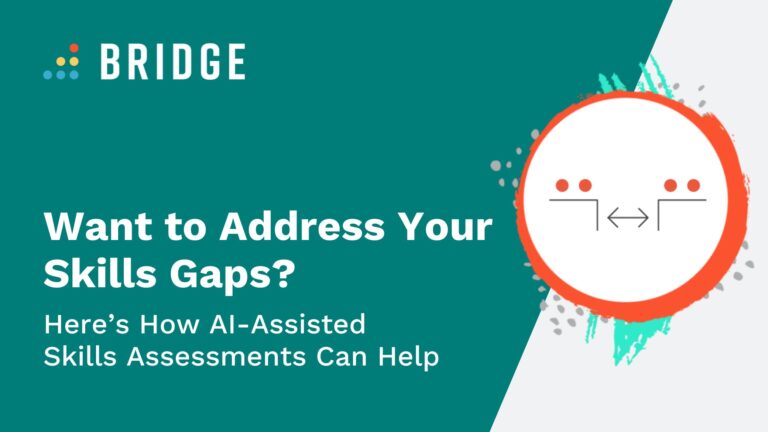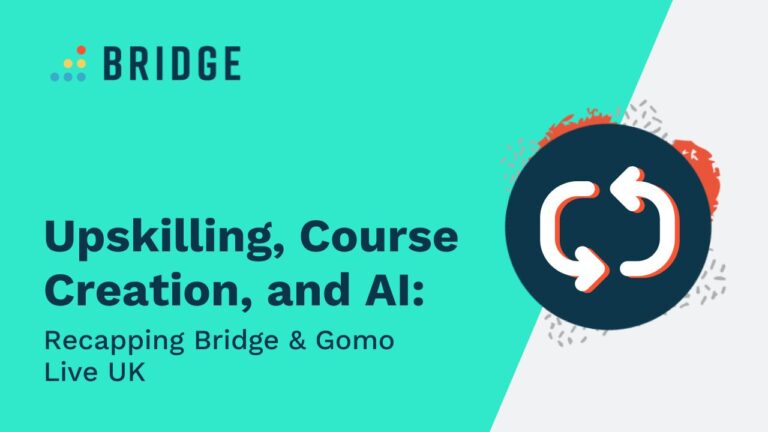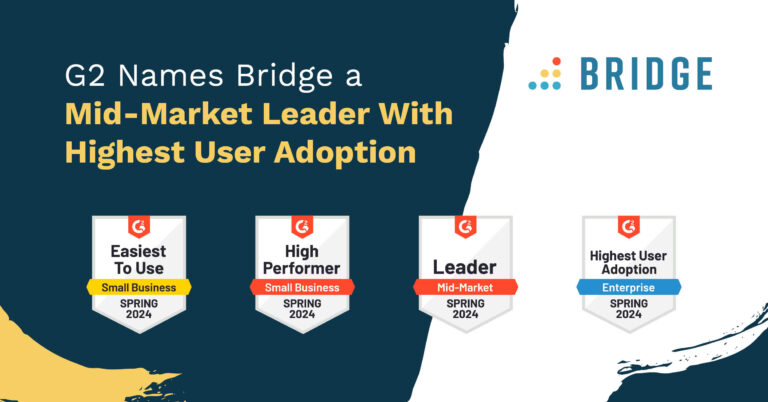Upskilling and reskilling: they’re huge priorities, and with skills gaps on the rise and AI skills tools emerging to meet the challenge, those priorities aren’t likely to change any time soon.
In fact, the need to upskill and reskill employees is a key theme running through the Bridge-sponsored Future of Learning Technologies 2023 report. New skills development was named as one of the top three drivers for learning among respondents’ organizations, and 49% went on to say that facilitating skills-based learning and development will be a key change for their learning tech over the next three years.
Despite this clear enthusiasm for upskilling and reskilling, the report also found that just under a third (30%) of respondents’ learning systems have skills gap-related capabilities. In other words, the vast majority of organizations don’t necessarily have the technology they need to address skills gaps—even if they recognize the value of skills development.
So, how do you address skills gaps and start thinking strategically about employee skills? And what AI platforms and tools can help you get the ball rolling? It all starts with a solid skills assessment. Read on to find out:
- What skills assessments are
- How you might conduct your own skills assessments
- How the right tech can help you (and your employees) recognize skills requirements that aren’t being met
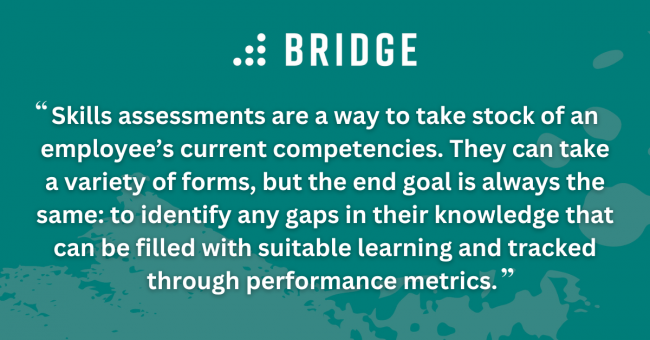
What Are Skills Assessments, and How Do They Inform Employees’ Learning and Development Objectives?
Skills are the glue that bind training software, performance management systems, and upskilling platforms together. If your organization is looking to get serious about L&D, then you need to recognize that your learning, performance, and mobility practices are intimately connected to the skills your people have—and the ones they’ve yet to acquire.
The need for new or updated skills adds a layer of meaning and purpose to your learning programs, and skills acquisitions are fantastic goals that can be used to measure employee performance and progress.
Of course, there’s no point in encouraging your people to learn if they’re not going to gain skills at the end of the process. By the same token, there’s no point in directing them to gain skills unless they’re necessary, relevant, and not yet part of your employees’ existing skillsets. That’s where skills assessments come in.
Skills assessments are a way to bolster employer perspectives on their workforce’s skills by taking stock of employee competencies. These assessments can take a variety of forms, but the end-goal is always the same: to identify any gaps in employees’ knowledge that can be filled with suitable learning and tracked through performance metrics. According to HR professionals and hiring managers, 69% of organizations now face skills gaps—so you’d be right to assume that skills assessments are as essential now as they’ve ever been.
So, the need for skills assessments is clear—but what do they look like in practice?
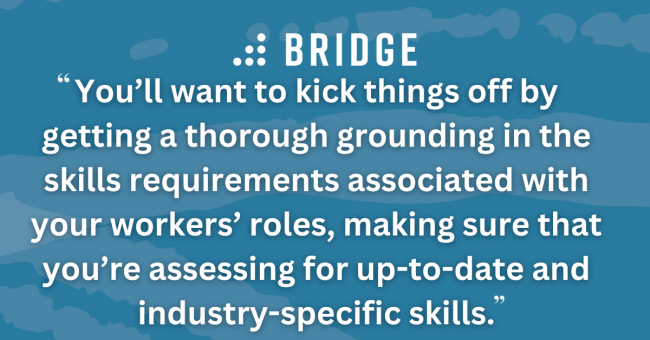
4 Ways to Conduct an Employee Skills Assessment (And How an AI Skills Platform Can Help)
There are plenty of forms that skills assessments can take, and they’re not mutually exclusive—you can incorporate a variety of scenarios into the process as appropriate. But before you begin the process of uncovering skills gaps, you’ll want to get an idea of what skills you want to assess for each employee.
On the surface, this might feel like a pretty simple exercise. After all, you must know what your people’s main skills should be, right?
In practice, it’s not always that easy. Sure, you can hunt down your reports’ job descriptions—but plenty of skills gaps are a result of changing skills requirements, and you might not know what new priorities have emerged in each employee’s field. Even if you’re confident that you know the skills needed for a given job role, requirements can vary by industry. Healthcare organizations and financial services firms might both employ project managers, but that doesn’t mean the Venn diagram of their respective skills requirements will be a perfect circle.
As such, you’ll want to kick things off by getting a thorough grounding in the skills requirements associated with your workers’ roles, making sure that you’re assessing for up-to-date and industry-specific skills. An AI-powered skills platform like Bridge’s Skills Plus will be your friend here. The right platform will use AI to draw from vast skills libraries that take the most up-to-date requirements into account, saving you the administrative trouble of doing it manually and the financial burden of relying on consultants.
Once you know what skills you’re looking for, it’s time to see whether your people have them or whether you’re looking at a skills gap. There are a few options here, so let’s break them down.
Method 1: Self-Assessment
In many ways, your employees are best qualified to assess your organization’s skills development needs—and self-assessments are a great way to unlock those insights.
Self-assessments will often take the form of a quiz or questionnaire that asks your people about their own strengths and weaknesses, giving you an overview of their current skills straight from the people at the heart of the process.
Obviously, self-assessments aren’t exactly immune to bias, so you might want to pair this method with one or two other assessment types. That said, an AI upskilling platform will include a profile-building component in which employees are prompted to select the skills they have from a list of the same up-to-date recommendations we discussed earlier. This handy capability might just lead your people toward an even more frank assessment of their own abilities and their personal skills gaps.
LEVERAGE YOUR INSIGHTS | ‘The Power of People Analytics: How to Turn People Data Into Business Results’
Method 2: Peer Assessment
As the name suggests, peer assessments involve soliciting feedback from your workers’ peers. There are valuable insights to be gleaned here: you might find that your people spend more of their working time among their peers than, say, interacting with managers, so they’ll likely be able to offer a fairly comprehensive view of each other’s possible skills gaps without the same biases that can inflect self-assessments.
Peer assessments are also a handy way to assess specific types of skills in your employees, especially socially-oriented soft skills. Teamwork, for example, is something a manager wouldn’t necessarily be able to assess from direct experience, but teammates contributing to a peer review will have a much more accurate understanding of any skills gaps undermining those vital competencies.
While you’re getting your head around the practicalities involved in this assessment method, don’t forget to take advantage of any peer feedback mechanisms within your performance management system. You might find that your system can collect peer assessments via email prompts and preserve that all-important anonymity.
Method 3: Manager-Led Performance Reviews
Your managers are likely conducting performance reviews already—and, if your organization opts for a continuous feedback approach, reviews and feedback sessions will be a fairly common occurrence. So, why not throw a few manager-led skills assessments into the mix?
As the custodians of your performance management process, managers can be well-placed to recognize skills gaps within your workforces. Like all manager reviews, this process can be susceptible to things like recency bias—but with performance data at their fingertips and with other assessment methods backing them up, managers can offer some great perspectives on any skills gaps your teams develop.
RELATED READING | ‘Power Up Your Performance Management With Bridge’
Method 4: Formal Testing
You can supplement these methods by incorporating an assessment in the formal sense of the term. Depending on the role or skills involved, you might be able to ask your people to demonstrate their ability to perform a given skill.
This can be easier with hard skills than soft ones—but by incorporating a mix of methods, you’ll be left with a well-rounded picture of your people’s proficiencies and skills gaps that you can use to inform your next steps.
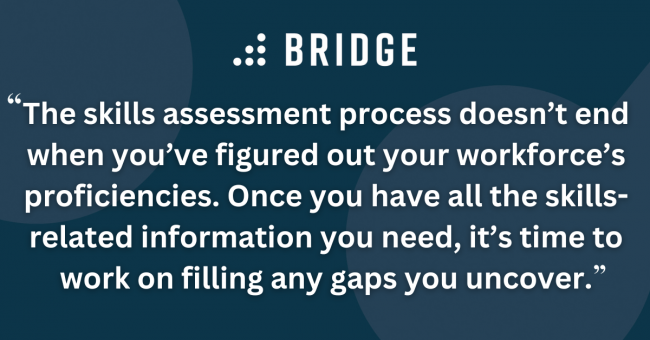
L&D Tech Tools and Features for Delivering Assessments and Filling Skills Gaps
Across these four methods, there’s no question that a range of L&D technologies can make the skills assessment process as comprehensive (and simple!) as possible. As we’ve seen, you can use:
- An AI-powered employee upskilling platform to get a sense of the skills requirements attached to a given role in a given industry
- A performance management system to solicit peer feedback about possible skills gaps
- Your existing performance review and manager feedback infrastructure for manager-led skills assessments
On top of these tools, it’s worth bearing in mind that the skills assessment process doesn’t end when you figure out your workforce’s proficiencies. Once you have all the skills-related information you need, it’s time to improve employee skills and fill any skills gaps you uncover.
As you may have guessed, a learning management system is a great platform to have in your corner here, as you can assign courses targeted specifically to the skills gaps your people exhibit. This is the perfect way to squeeze the maximum amount of employee development potential from your LMS.
You’ll find that the advantages offered by these individual tools are even more pronounced when your L&D software is integrated under one roof. For example, let’s say you have an AI skills platform like Skills Plus, which is able to tag your learning courses with the skills they teach. When your employees enter their existing skills into their profiles, the platform will be able to instantly suggest learning resources from your LMS based on the required skills for each employee’s role. That way, your people will gain access to the learning they need in order to fill any skills gaps, effortlessly transforming skills insights into developmental action.
MORE ABOUT TALENT TOOLING | ‘Unlock AI-Powered Upskilling and Motivate Employee Development With Bridge’
Conduct Comprehensive Skills Gap Analyses With Bridge’s AI Upskilling Platform
Bridge’s AI upskilling platform, Skills Plus, is powered by a vast library of over 32,000 skills. With Skills Plus, you can facilitate self-assessments via the AI-powered skills recommendations presented to employees from the moment they start to build their profiles. The platform can also tag learning courses with the skills they offer, giving your people instant access to the resources they need to address any skills gaps that your assessments uncover. Get a demo or reach out to one of our expert sales advisors to discover the power of Skills Plus.
